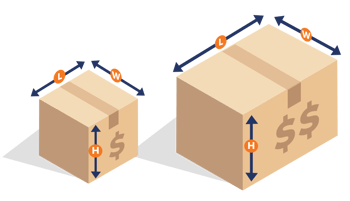Originally published on February 16, 2023, updated September 6, 2024
Menu
Join Our Email List
- Receive our monthly newsletter.
- Stay up to date on Amazon policies.
- Get tips to grow your business.
Struggling with staying profitable in the new year? You may think that raising your product prices is the only way to keep up with inflation, but this can start to drive away even the most loyal customers. In this guest article, eCommerce Nurse shares helpful advice for how to save money without hiking up your pricing.
Inflation was painfully high in 2022, with the Fed clocking the highest interest rate in 15 years. There’s no doubt that increased gas prices, supply chain issues, and compounded hikes affected consumers everywhere. Amazon is no exception in this economy as new, significantly higher FBA (Fulfillment by Amazon) fees just went into effect for the new year.
These increased fees will affect hundreds of millions of products and thousands of businesses using Amazon as a sales channel, forcing sellers like you to absorb more costs.
While many eCommerce businesses will raise their product prices to keep pace with inflation and other industry cost increases, this can be a tough pill to swallow for consumers who shop online and are interested in scoring deals. The start of the year is a great time to take a hard look at profitability, goals, and sales plans for the year ahead.
With that thought in mind, here are six ways to save money without raising product prices plus other tips for how to price on Amazon.
Amazon has increasingly become pay-to-play, with much more reliance on paid search than even a few years ago. Amazon has also increased its ad options and levers for each as a revenue driver for its own business model. Video ads, display ads, Sponsored Products, Sponsored Brands, and more can all factor into an FBA business's strategy. But this approach can be exponentially expensive, especially for companies with large catalogs or heavy competition to outbid.
You can stretch your ad budgets even further by honing in on a strategy to lower ACOS (Advertising Cost of Sale). This can be done a few ways, but it’s essential for you to refine it. Looking at your past performance and eliminating ads or creatives that are underperforming is a good place to start. Consider moving some money to specific ad types that work more effectively for you.
Then, if your business has a good return on investment with Amazon Advertising, try investing in software to optimize ACOS and increase ROAS (Return on Ad Spend) even more. It’s also important not to "set it and forget it" when it comes to ads. Schedule time to revisit your ads and review their performance on a regular basis. You'd be surprised at how much you can potentially save!
Related reading: How to Improve Your Amazon Targeted Ads
FBA encompasses a lot of different aspects, from marketing to data analytics. But logistics is one area that can be improved to increase your net profits and keep you running lean. Here are a few examples of things you can do to make your FBA account more efficient and less costly.
Related reading: 8 Sneaky Ways Amazon Gets Your Money
 Amazon fees are determined by the size and weight of the item. If these are even slightly off, you can hemorrhage money faster than you may realize. Amazon can re-measure and update the dimensions for any item in your catalog without notice and start charging you higher fees if its measurements classify products in a different tier.
Amazon fees are determined by the size and weight of the item. If these are even slightly off, you can hemorrhage money faster than you may realize. Amazon can re-measure and update the dimensions for any item in your catalog without notice and start charging you higher fees if its measurements classify products in a different tier.
You can file a ticket to request a re-measure via Seller Support if you believe the measurements are incorrect. If something is amiss, you can also request reimbursement for inaccurate charges. This can save a lot of money upfront and over time.
Much like FBA fees, storage fees are charged based on the space items take up in Amazon fulfillment centers. Fees can also be higher during peak periods. Storing a lot of inventory (especially if it isn’t selling) can add thousands of dollars to your charges.
Related Reading: Breaking Down Amazon's New FBA Capacity Limits
Amazon offers ways to keep an eye on this, including fee estimations, IPI scores, forecasted demand, and more. Be sure to use the various tools at your disposal (including software like RestockPro by eComEngine) to optimize your FBA inventory management and cut down on as many avoidable fees as you can.
Sending unprepped inventory to Amazon will cost you more in fees and delay intake times, which also means higher storage payments. Labeling, bagging, and bubble wrapping can cost as much as $2 per unit. If you're moving large quantities, Amazon prep costs can add up dramatically.
It’s much more efficient to do this on your end rather than Amazon. Manufacturers or third-party logistics companies can often do this for as little as $0.03 per unit.
Claiming money that’s due because of an Amazon error is very common. Discrepancies often exist, and sellers can claim back charges for damaged products, missing items, and more. To claim this, you will need to document FBA orders and make time to file claims with Amazon Support.
It may take a little work, but it’s worth it even if this results in just 1% back on your sales each year. Third-party companies exist and can also do this for you for a percentage of the chargeback. This is very much worth the time to set up, especially as your business grows.
Even if all of the weights and sizes Amazon has are accurate, it’s a good time to review your packaging all the way back through the supply chain. Eliminating excess waste and making sure box sizes are tight (and not full of air or bubble wrap) can save a lot as orders increase.
Consider ways to repack or consolidate items to save money. You could use bags instead of boxes, go with generic boxes over branded ones, eliminate bulky inserts, and more.
As a seller, it’s often necessary to outsource tasks to the multitude of software solutions available. But over time, these subscriptions can add up without providing value to your organization.
Be careful here; business could potentially take a drastic turn if you misstep. However, there are surely a few services that you can downgrade or even eliminate to save some money each month. The start of the year is a nice time to review any contracts and services and assess how to make use of them more efficiently.
Oftentimes, a good old-fashioned deep dive can reveal pain points and areas for improvement as it requires you to step back and look at each ASIN. As Amazon increases fees and margins tighten, it may be time to really look at your catalog and understand what’s working and what can be cut.
Many sellers and vendors on Amazon carry too many products. This results in tons of fees for each (from marketing to logistics) that can simply be too pricey to maintain. Most businesses do not sell their full catalogs on Amazon exactly for this reason. Choosing top lines to focus on (and invest more fully in) can be super effective for increasing your overall profitability.
For example, do not have a catalog of 200 SKUs on Amazon if your business can only fully support 25% of that. Do not continually add more options if they’re not demonstrated successes that sell well.
Amazon has increasingly allowed and expanded upon the ability of sellers to test and learn on the platform. Focus on the most successful and highest-return items and constantly improve those to further maximize profits.
This can include image and title tests, A+ Content comparisons, and more. If you see a 10% boost in clicks from a test, consider implementing those learnings across other ASINs. This attention to detail and tenacity can really add up for businesses.
Remember, Amazon is not a set-it-and-forget-it marketplace. Paying attention to maintaining your top-performing ASINs can benefit any business, large or small. If you’re unsure where to start with content, contact an agency such as eCommerce Nurse.
 Finally, if you must raise your prices, pay close attention to the margin percentage. Raising prices is not always avoidable, especially if you’ve tried all the options above and are still not making a profit. If you must raise prices, try to do so logically.
Finally, if you must raise your prices, pay close attention to the margin percentage. Raising prices is not always avoidable, especially if you’ve tried all the options above and are still not making a profit. If you must raise prices, try to do so logically.
For example, rather than keeping margins a uniform 40% across all ASINs, you strategically raise the price of your best-selling product slightly less to account for increased sales volume. Maybe some ASINs have a high repurchase rate and you can account for this in the price structure.
Alternatively, consider raising prices slightly higher than needed to account for coupons and discounts, which can be very effective for increasing customer click-through rates. The bottom line is any price increases should be well thought-out and justified rather than just passing along fees that could be eliminated to your loyal customers.
As usual, there is no one-size-fits-all approach to pricing or overall strategy for how to price on Amazon. It is evident that a focused and tailored approach can require a solid combination of analytical skills, knowledge of the platform, and willingness to test and learn.
If you have questions about Amazon account management, be sure to reach out to the pros. eCommerce Nurse is a full-service agency that can guide your Amazon business through any hurdle. Hopefully, these tips will come in handy as you look to grow and sustain your business.
Originally published on February 16, 2023, updated September 6, 2024
This post is accurate as of the date of publication. Some features and information may have changed due to product updates or Amazon policy changes.
These Stories on Business
14321 Winter Breeze Drive
Suite 121 Midlothian, VA 23113
Call us: 800-757-6840





Copyright© 2007-2025 eComEngine, LLC. All Rights Reserved. eComEngine®, FeedbackFive®, RestockPro®, and SellerPulse® are trademarks or registered trademarks of eComEngine, LLC. Amazon's trademark is used under license from Amazon.com, Inc. or its affiliates.
No Comments Yet
Let us know what you think